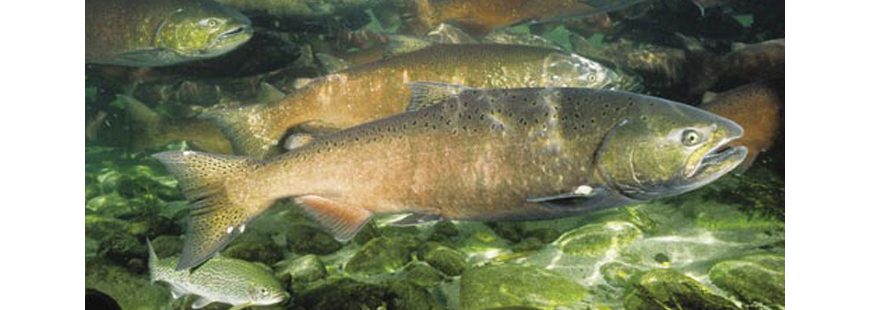This is a perilous moment for California’s salmon and the communities and businesses that depend on them. As has been widely reported, and as many experts have agreed, the endangered Sacramento River Winter-run Chinook Salmon, which spawns solely in the Sacramento River and its tributaries, could be facing total annihilation this year. But it’s also dangerous because we’re seeing it before our eyes, we know it’s happening, and yet some decision makers have chosen to ignore the lessons of the past and are actively letting it happen. And we cannot allow that to happen.
Salmon are tough. Tough and resilient. They have evolved to handle the rugged west, and they have certainly encountered periods of drought over the 15-20 million years they have existed. The great annual salmon migrations from ocean to headwaters were once the most significant transfer of energy and nutrients from the sea to the land in California’s geologic history. The migrations literally shaped the landscape.
But they did not evolve to withstand the serial depletion of their watersheds, the dewatering of their spawning gravels year after year, or the wholesale devastation of river systems that have been diverted to irrigate agriculture and serve urban water districts.
Today they hang on by a thread. With the high likelihood that every single juvenile salmon, ESA listed and unlisted, in the Sacramento River will die from in-river water temperatures that are too warm, we need to replot the course and take on a make-or-break mentality for these fish, our fishermen, and the communities and business that rely upon them.
Silver Fish, Silver Linings
What’s extraordinary, and sometimes perplexing, is that this year’s ocean salmon fishery is exceeding expectations. While preseason forecasts of salmon abundance (specifically the fall run Chinook, which are not endangered) were low and fisheries management resulted in reduced time on the water, regulatory agencies have estimated that, as of July 19, California commercial fishermen have harvested just under 137,000 fish, which puts this season on track to be an economically successful one. Harken back to Salmon 101 and you’ll remember that in California, the majority of the Chinook harvested in the ocean are 3-year-old fish. This means we’re catching fish in the 2018/19 cohort this year, spawned during a period of relative water bounty and before devastating federal administration water policies were put in place later in 2019.
Another silver lining is the progress made to remove four derelict dams on the Klamath River. This will be a globally significant event, as the removal project will be the largest dam removal enterprise in human history. It will free up dozens of miles of salmon spawning and rearing habitat, improve water quality and lower temperatures, and return the hydrology of the river to more natural patterns. And when Klamath River salmon return to healthy levels, we will see eased constraints on ocean and river harvest. The California portion of the Klamath Management Zone has been closed to all commercial harvest of salmon the past two years.
Learning, and Failing to Learn, from the Past
In 1985, California issued roughly 5,000 commercial salmon permits. By 2020, there were a bit over 1,000 permits – 472 vessels made at least one landing and 64 of those accounted for half of the total landings. Less than 10% of the original fleet is left fishing – after 35 years. Unless this trend is reversed, there will be few harvesters, and so few salmon to harvest, that the commercial fishery will no longer be economically viable.
We need to implement drought and salmon management policies that reflect the dire threat faced in the Sacramento River today. We must increase flexibility in hatchery operations to maximize the chances of juvenile salmon survival, because the hatcheries are close to all that these fish have left.
We need to continue our enhanced hatchery trucking programs as long as drought and water policies work together to create in-river conditions lethal to fish. We also need to get creative and implement visionary policies like covering irrigation canals with solar panels to reduce evaporative water loss and generate gigawatts of renewable energy.
Elevating the Fight
We won’t be able to engineer our way out of the drought catastrophe unless we also change our political approach to water. What we got from Washington from 2016 to 2020 were actions and policies designed to “maximize” the transfer of as much of our water wealth as possible from rivers to agriculture. Early last year former California Attorney General Becerra joined our organization in suing the last administration for violating the Endangered Species Act and enacting a water operations plan that was designed to facilitate extinction, allowing three years of near 100% salmon mortality (three complete cohort cycles, allowing for total extinction) before remedial action is taken.
While the new administration has signaled that it may revert back to more protective measures later this fall, that could be too little too late. Earlier this year the salmon-killing operations plan was used by federal water managers to set the pace for water diversions, and it was approved by state agencies despite California’s own litigation against the plan. One can’t be blamed for wondering why.
We have a lot more fighting to do to right the wrongs of the past four years and re-learn the lessons of drought, which some seem to have forgotten over a single drought cycle. And we must. The alternative, the loss of California’s salmon, is simply unacceptable.


